
Black and white selenite crystals, Cueva de las Espadas, Mexico.
Part 2. Caves of Naica Mine
Naica Mine south from Ciudad Chihuahua is one of the largest
in Mexico, producing about a million ton of lead, zinc, copper, silver and gold
annualy. It also provides access to two little-known, but unique caves.

Naica Mine, Chihuahua. |
Visits are possible only on weekends,
2-3 times a month. You have to make reservations well in advance (in Spanish),
and pass a medical exam. Then you take a long truck ride down a spiraling tunnel.
|
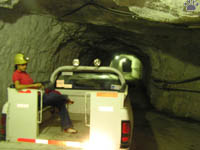
Going down Naica Mine. |
 |
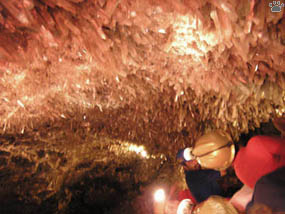 |
| Selenite seems colorless, but its
color depends on the light. Here are two pictures, taken with and without flash.
Cueva de las Espadas. |
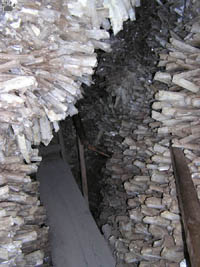
Path through Cave of Swords. |
The first cave, discovered in 1910,
is called Cueva de las Espadas (Cave of Swords). It is 80 m (250') long, lies
at the depth of 120 m (400'), never had a natural entrance, and is almost entirely
lined with crystals of selenite (crystalline gypsum, i.e. hydrated calcium sulfate).
Most crystals in this cave are not very large, but some are over 1 m (3') long.
|
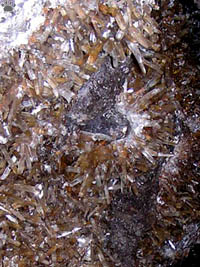
Selenite crystals, Cave of Swords. |
 |
 |
| Endless "fields" of selenite
crystals. Cueva de las Espadas. |
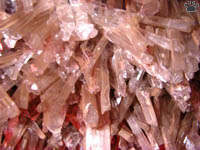
Selenite crystals. Cueva de las Espadas. |
At first they all look the same, but
soon you notice an endless variety of shapes and colors. Pink, yellow, white,
blue, or brown crystals can look like pensils, needles, swords, cubes and stars.
|
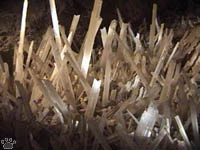
Selenite crystals, Cave of Swords. |
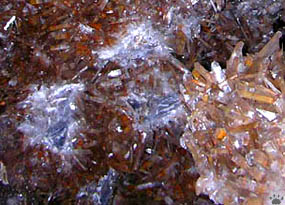 |
 |
| Selenite crystals. Cueva de las Espadas. |

Selenite crystals. Cueva de las Espadas. |
Black selenite is very rare, but it
makes the most beautiful crystals. Cave of Swords has more black selenite crystals
than any other place. Some are large and perfectly shaped. |
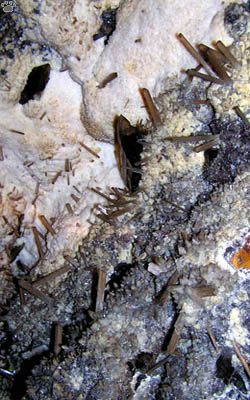
Selenite crystals, Cave of Swords. |
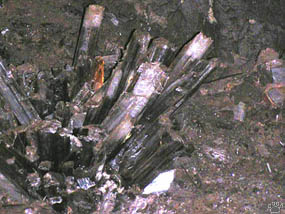 |
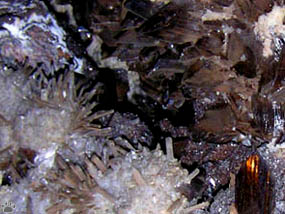 |
| Selenite crystals. Cueva de las Espadas. |
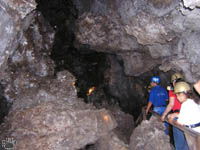
Exploring Cueva de las Espadas. |
Large numbers of selenite crystals
occur in some other caves in the world, including a few deep caves in Chihuahua,
but none has as many as Cave of Swords. Still, it's just a warm-up for what's
ahead.
|
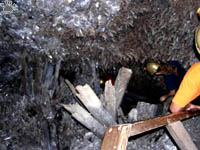
Exploring Cueva de las Espadas. |

Cueva de los Cristales is only a short walk from one of mine tunnels. |

Selenite "beams", Cueva de los Cristales. |

Exploring Cueva de los Cristales. |
The second cave, Cueva de los Cristales,
discovered in 1990 at the depth of 300 m (1000'), is 30 m (100') in diameter.
The temperature in the cave is over 70C (170F), and humidity is 100%. The cave
is filled with the largest natural crystals ever found on Earth: transparent selenite
columns up to 1 m (3') in diameter and 30 m (100') long. |
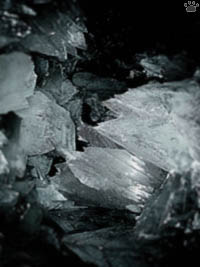
Exploring Cueva de los Cristales. |
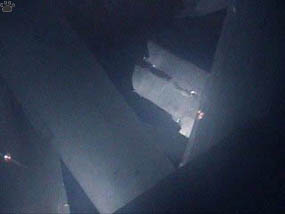 |
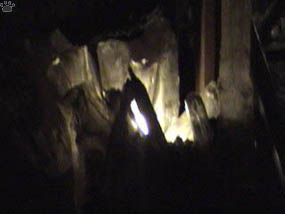 |
| Giant selenite crystals. Cueva de
los Cristales. |
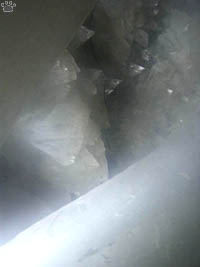
Giant selenite crystals. Cueva de los Cristales. |
They criss-cross it in all directions
like windfallen trees or concrete beams in a semi-collapsed building. Photographing
them is almost impossible: camera lens instantly get fogged. Using mask defogger
and constantly wiping the lens, I managed to get a few more or less clear pictures
out of a hundred or so misty ones.
Author thanks Penoles Company employees for their help in visiting the caves and for their efforts in protecting these unique wonders. |
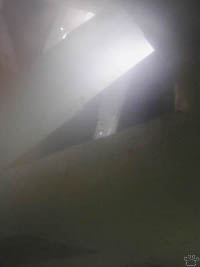
Giant selenite crystals. Cueva de los Cristales. |
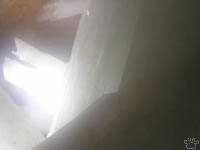
Giant selenite crystals. Cueva de los Cristales. |
Part 3. Caves of Tropical Latin America
Back to Part 1
Home
|